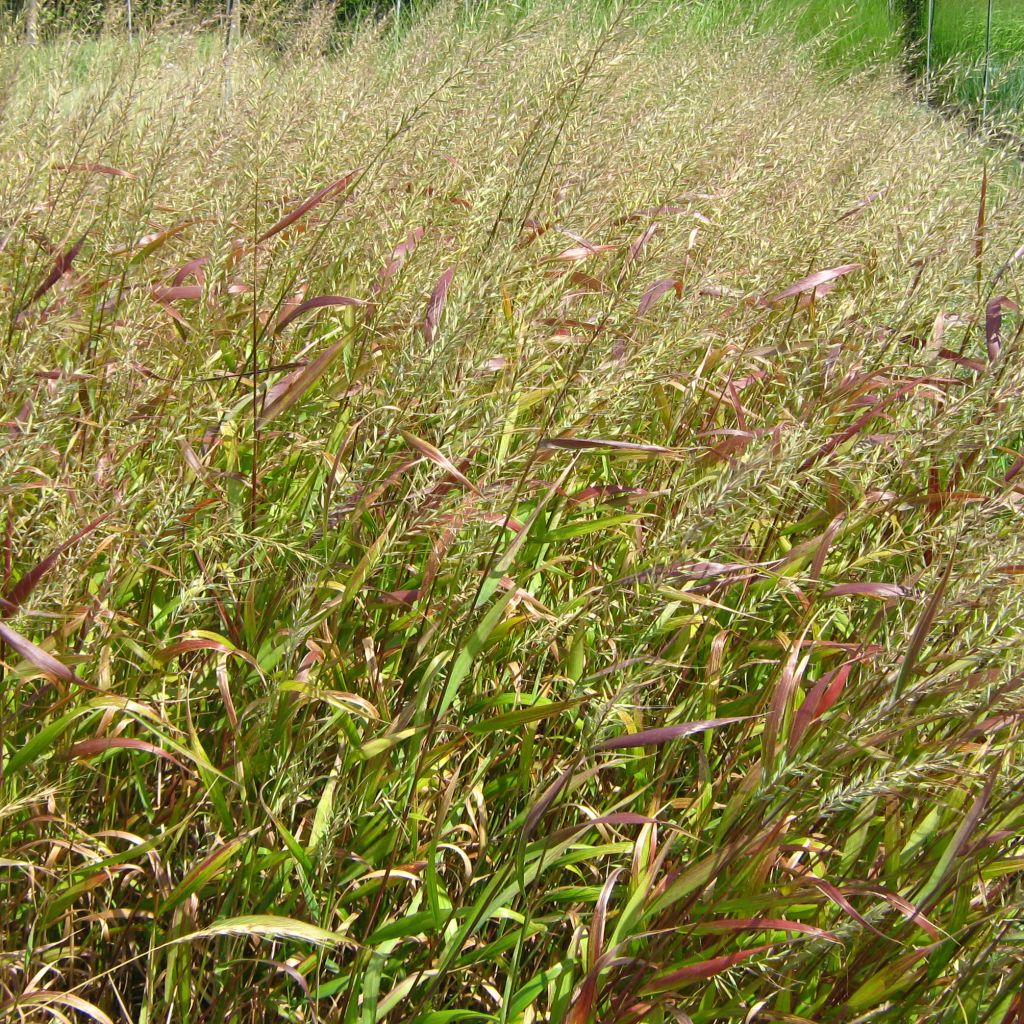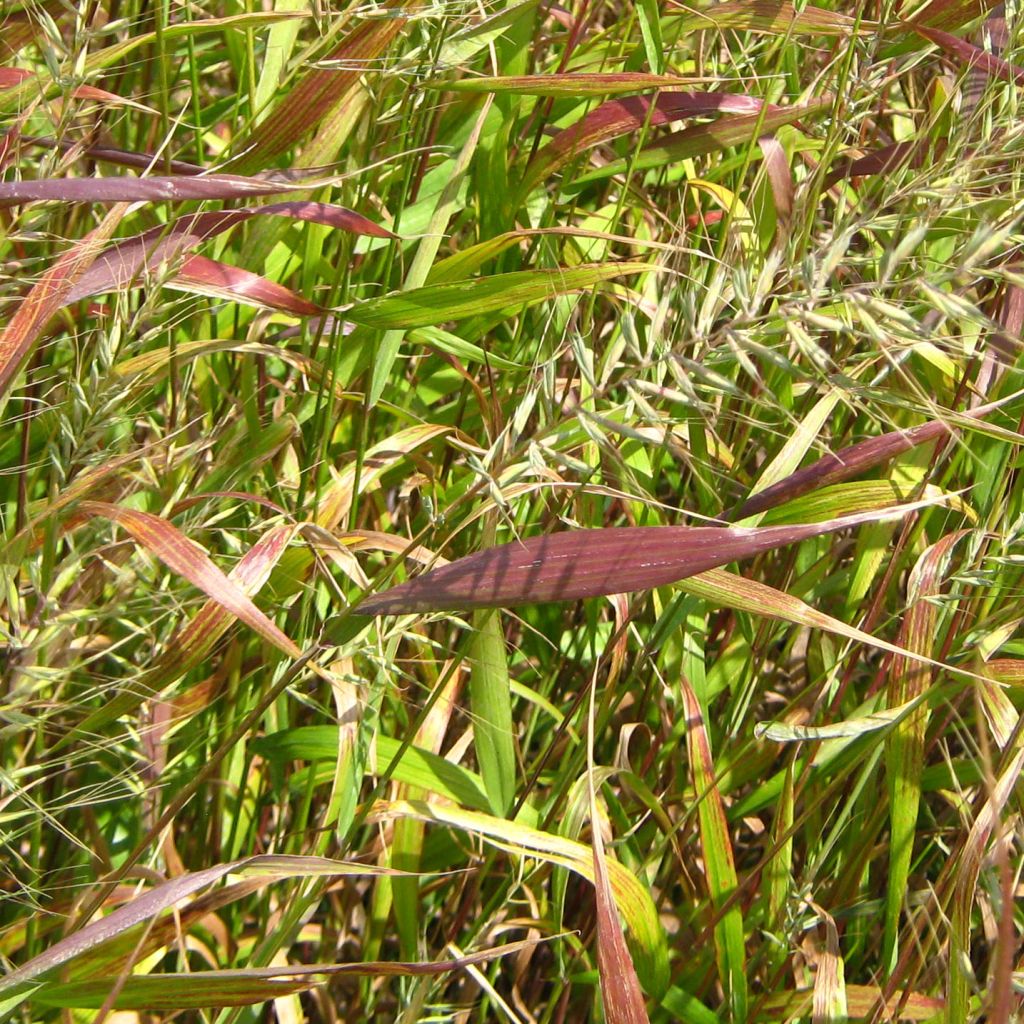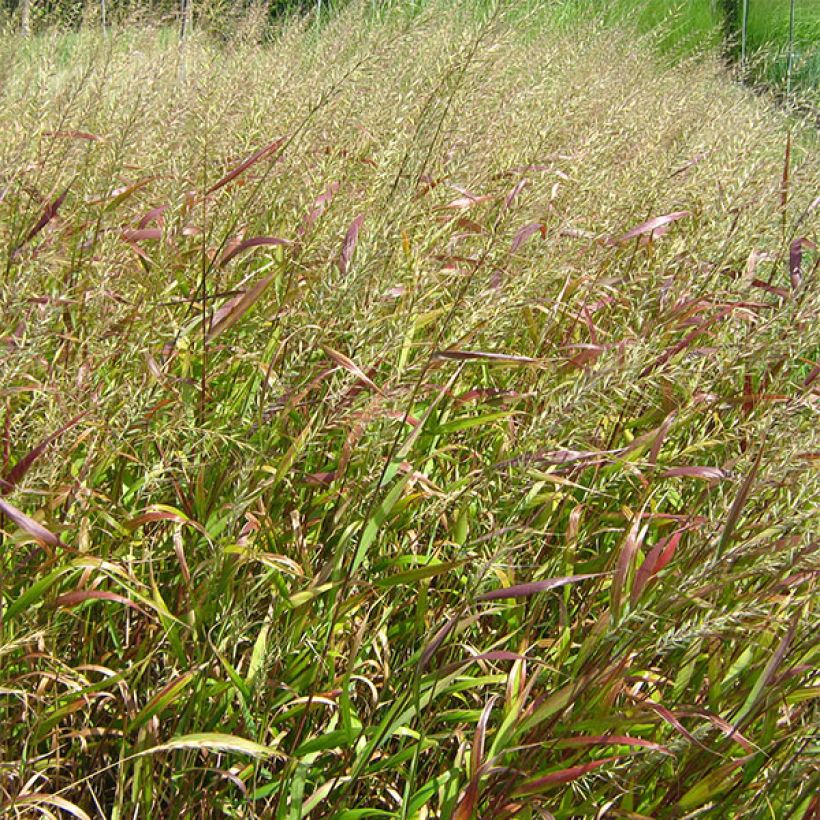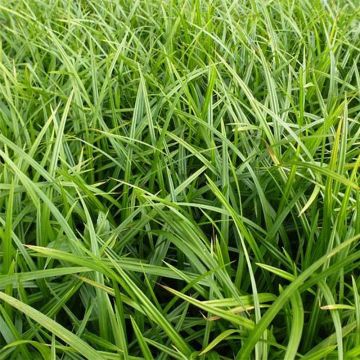

Hystrix patula


Hystrix patula
Hystrix patula
Hystrix patula
Spreading Bottlebrush Grass
3 plants ordered, all dead.
Isabelle, 27/05/2024
This item cannot be shipped to the selected country
Delivery charge from €5.90
More information
Schedule delivery date,
and select date in basket
This plant carries a 12 months recovery warranty
More information
We guarantee the quality of our plants for a full growing cycle, and will replace at our expense any plant that fails to recover under normal climatic and planting conditions.
From €5.90 for pickup delivery and €6.90 for home delivery
Express home delivery from €8.90.

Does this plant fit my garden?
Set up your Plantfit profile →
Description
Hystrix patula is a tall ornamental grass ideal for shade, as it is one of the few that thrives and flowers there, even in dry soil. It forms an upright clump with glaucous green leafy stems often tinged with brown-purple and is covered in summer with upright and stiff inflorescences, shaped like brushes, highly appreciated in dried flower bouquets. Playing with backlight, this very beautiful species illuminates the undergrowth. Undemanding and easy to grow, it is satisfied with ordinary soil, even occasionally dry, and naturalises easily in sandy soil.
Hystrix patula, sometimes called Asprella hystrix, and recently renamed Elymus hystrix, is a perennial grass with fibrous rhizomes native to the undergrowth of Missouri, belonging to the family of Poaceae. The plant has an upright habit, formed by a clump of leafy culms, reaching 80cm (32in) to 1m (3ft) in height, with a diameter of about 30cm (12in) at the base. The young spring leaves are glaucous green, slightly shiny, often tinged with purple or brown in summer, dying back in winter. The foliage is deciduous, composed of wide leaves of 7 to 15mm (0 to 1in), flat. Flowering occurs in summer, from June to August depending on the climate, in the form of upright panicles bearing spikes of 8 to 15cm (3 to 6in) long, consisting of awned spikelets arranged in brushes, initially greenish and then golden at ripeness. These inflorescences are appreciated in floristry, for dried flower arrangements. Hystrix patula spreads slowly through its rhizomes, eventually forming small colonies.
Perfect for deciduous understory and wild areas, Hystrix patula brings a light structure and lots of life to shaded areas of the garden. It is also a wonderful perennial that grows on its own, in natural areas, or in a modern garden with clean lines. Just plant it among ferns (Osmundas, Dryopteris filix mas), foamflowers, and small periwinkles, under a mass of deciduous bushes, and watch it filter the oblique rays of light through its delicate flowers. This 'grass' will also be magnificent in the company of dwarf conifers. In an urban garden, it will soften concrete structures.
Report an error about the product description
Hystrix patula in pictures




Flowering
Foliage
Plant habit
Botanical data
Hystrix
patula
Poaceae
Spreading Bottlebrush Grass
North America
Other Ornemental grasses A to Z
Planting and care
Prepare a planting hole measuring 30cm (12in) x 30cm (12in) x 30cm (12in). Choose a shaded or semi-shaded location, with sandy or loamy soil, light and rather fertile, ideally under deciduous trees or bushes that allow air and light to pass through in winter. If your soil is heavy, mix gravel and compost into the crumbled soil, partially refill the hole and place your young plant so that the top of the root ball is covered with 3cm (1in) of soil. Firmly press down the soil and water generously to eliminate air pockets. If the weather is dry, you will need to water regularly for a few weeks to facilitate the establishment of your plant. This deciduous grass renews its foliage in spring. We recommend cutting back your plants to 10cm (4in) at the end of January or the beginning of February for a tidier look and to make room for new foliage.
Planting period
Intended location
Care
-
, onOrder confirmed
Reply from on Promesse de fleurs
Evergreen perennials
Haven't found what you were looking for?
Hardiness is the lowest winter temperature a plant can endure without suffering serious damage or even dying. However, hardiness is affected by location (a sheltered area, such as a patio), protection (winter cover) and soil type (hardiness is improved by well-drained soil).

Photo Sharing Terms & Conditions
In order to encourage gardeners to interact and share their experiences, Promesse de fleurs offers various media enabling content to be uploaded onto its Site - in particular via the ‘Photo sharing’ module.
The User agrees to refrain from:
- Posting any content that is illegal, prejudicial, insulting, racist, inciteful to hatred, revisionist, contrary to public decency, that infringes on privacy or on the privacy rights of third parties, in particular the publicity rights of persons and goods, intellectual property rights, or the right to privacy.
- Submitting content on behalf of a third party;
- Impersonate the identity of a third party and/or publish any personal information about a third party;
In general, the User undertakes to refrain from any unethical behaviour.
All Content (in particular text, comments, files, images, photos, videos, creative works, etc.), which may be subject to property or intellectual property rights, image or other private rights, shall remain the property of the User, subject to the limited rights granted by the terms of the licence granted by Promesse de fleurs as stated below. Users are at liberty to publish or not to publish such Content on the Site, notably via the ‘Photo Sharing’ facility, and accept that this Content shall be made public and freely accessible, notably on the Internet.
Users further acknowledge, undertake to have ,and guarantee that they hold all necessary rights and permissions to publish such material on the Site, in particular with regard to the legislation in force pertaining to any privacy, property, intellectual property, image, or contractual rights, or rights of any other nature. By publishing such Content on the Site, Users acknowledge accepting full liability as publishers of the Content within the meaning of the law, and grant Promesse de fleurs, free of charge, an inclusive, worldwide licence for the said Content for the entire duration of its publication, including all reproduction, representation, up/downloading, displaying, performing, transmission, and storage rights.
Users also grant permission for their name to be linked to the Content and accept that this link may not always be made available.
By engaging in posting material, Users consent to their Content becoming automatically accessible on the Internet, in particular on other sites and/or blogs and/or web pages of the Promesse de fleurs site, including in particular social pages and the Promesse de fleurs catalogue.
Users may secure the removal of entrusted content free of charge by issuing a simple request via our contact form.
The flowering period indicated on our website applies to countries and regions located in USDA zone 8 (France, the United Kingdom, Ireland, the Netherlands, etc.)
It will vary according to where you live:
- In zones 9 to 10 (Italy, Spain, Greece, etc.), flowering will occur about 2 to 4 weeks earlier.
- In zones 6 to 7 (Germany, Poland, Slovenia, and lower mountainous regions), flowering will be delayed by 2 to 3 weeks.
- In zone 5 (Central Europe, Scandinavia), blooming will be delayed by 3 to 5 weeks.
In temperate climates, pruning of spring-flowering shrubs (forsythia, spireas, etc.) should be done just after flowering.
Pruning of summer-flowering shrubs (Indian Lilac, Perovskia, etc.) can be done in winter or spring.
In cold regions as well as with frost-sensitive plants, avoid pruning too early when severe frosts may still occur.
The planting period indicated on our website applies to countries and regions located in USDA zone 8 (France, United Kingdom, Ireland, Netherlands).
It will vary according to where you live:
- In Mediterranean zones (Marseille, Madrid, Milan, etc.), autumn and winter are the best planting periods.
- In continental zones (Strasbourg, Munich, Vienna, etc.), delay planting by 2 to 3 weeks in spring and bring it forward by 2 to 4 weeks in autumn.
- In mountainous regions (the Alps, Pyrenees, Carpathians, etc.), it is best to plant in late spring (May-June) or late summer (August-September).
The harvesting period indicated on our website applies to countries and regions in USDA zone 8 (France, England, Ireland, the Netherlands).
In colder areas (Scandinavia, Poland, Austria...) fruit and vegetable harvests are likely to be delayed by 3-4 weeks.
In warmer areas (Italy, Spain, Greece, etc.), harvesting will probably take place earlier, depending on weather conditions.
The sowing periods indicated on our website apply to countries and regions within USDA Zone 8 (France, UK, Ireland, Netherlands).
In colder areas (Scandinavia, Poland, Austria...), delay any outdoor sowing by 3-4 weeks, or sow under glass.
In warmer climes (Italy, Spain, Greece, etc.), bring outdoor sowing forward by a few weeks.























































